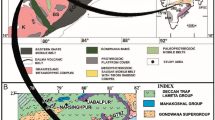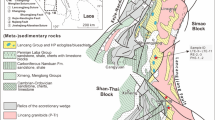Abstract
This work presents zircon U–Pb age and whole-rock geochemical data for the volcanic rocks from the Lakang Formation in the southeastern Tethyan Himalaya and represents the initial activity of the Kerguelen mantle plume. SHRIMP U–Pb dating of zircons from the volcanic rocks yielded a 206Pb/238U age of 147 ± 2 Ma that reflects the time of Late Jurassic magmatism. Whole rock analyses of major and trace elements show that the volcanic rocks are characterized by high content of TiO2 (2.62 wt%–4.25 wt%) and P2O5 (0.38 wt%–0.68 wt%), highly fractionated in LREE/HREE [(La/Yb)N = 5.35–8.31] with no obvious anomaly of Eu, and HFSE enrichment with no obvious anomaly of Nb and Ta, which are similar to those of ocean island basalts and tholeiitic basaltic andesites indicating a mantle plume origin. The Kerguelen mantle plume produced a massive amount of magmatic rocks from Early Cretaceous to the present, which widely dispersed from their original localities of emplacement due to the changing motions of the Antarctic, Australian, and Indian plates. However, our new geochronological and geochemical results indicate that the Kerguelen mantle plume started from the Late Jurassic. Furthermore, we suggest that the Kerguelen mantle plume may played a significant role in the breakup of eastern Gondwanaland according to the available geochronological, geochemical and paleomagnetic data.











Similar content being viewed by others
References
Antretter M, Steinberger B, Heider F, Soffel H (2002) Paleolatitudes of the Kerguelen hotspot: new paleomagnetic results and dynamic modeling. Earth Planet Sci Lett 203:635–650
Black LP, Kamo SL, Allen CM, Aleinikoff JN, Davis DW, Korsch RJ, Foudoulis C (2003) TEMORA 1: a new zircon standard for phanerozoic U–Pb geochronology. Chem Geol 200:155–170
Boynton WV (1984) Geochemistry of the rare earth elements: Meteorite studies. In: Henderson P (ed) Rare Earth element geochemistry. Elsevier, New York, pp 63–114
Chalapathi Rao NV, Srivastava RK, Sinha AK, Ravikant V (2014) Petrogenesis of Kerguelen mantle plume-linked Early Cretaceous ultrapotassic intrusive rocks from the Gondwana sedimentary basins, Damodar Valley, eastern India. Earth Sci Rev 136:96–120
Coffin MF, Pringle MS, Duncan RA, Gladczenko TP, Storey M, Müller RD, Gahagan LA (2002) Kerguelen hotspot magma output since 130 Ma. J Petrol 43:1121–1139
Curray IR, Munasinghe T (1991) Origin of the Rajmahal traps and the 85°E ridge preliminary reconstructions of the trace of the Crozet hotspot. Geology 19:1237–1240
Davies GF, Richards MA (1992) Mantle convection. J Geol 100:151–206
Davies HL, Sun SS, Frey FA, Gautier I, McCulloch MT, Price RC, Bassias Y, Klootwijk CT, LeClaire L (1989) Basalt basement from the Kerguelen Plateau and the trail of a Dupal plume. Contrib Miner Petrol 103:457–469
Duncan RA, Storey M (1992) The life cycle of Indian Ocean hotspots. In: Duncan RA, Rea DK, Kidd RB, von Rad U, Weissel JK (eds) Synthesis of results from scientific drilling in the Indian Ocean, vol 70. Geophysical Monograph. American Geophysical Union, Washington, pp 91–103
Frey FA, McNaughton NJ, Nelson DR, Delaeter JR, Duncan RA (1996) Petrogenesis of the Bunbury Basalt, western Australia: Interaction between the Kerguelen plume and Gondwana lithosphere? Earth Planet Sci Lett 144:163–183
Frisch W, Mesched M, Blakey R (2011) Plate tectonics. Springer, Heidelberg
Gansser A (1980) The significance of the Himalayan suture zone. Tectonophysics 62(1–2):37–52
Heine C, Müller RD (2005) Late jurassic rifting along the Australian north west shelf: margin geometry and spreading ridge configuration. Aust J Earth Sci 52:27–39
Hofmann AW, White WM (1982) Mantle plumes from ancient oceanic crust. Earth Planet Sci Lett 57:421–436
Ingle S, Weis D, Scoates J, Frey F (2002) Relationship between the early Kerguelen plume and continental flood basalts of the paleo-eastern Gondwanan margins. Earth Planet Sci Lett 197:35–50
Ingle S, Weis D, Doucet S, Mattielli N (2003) Hf Isotope constraints on mantle sources and shallow-level contaminants during Kerguelen hotspot activity since ~120 Ma. Geochem Geophys Geosyst. doi:10.1029/2002GC000482
Ingle S, Scoates JS, Weis D, Brügmann G, Kent RW (2004) Origin of Cretaceous continental basalts in southwestern Australia and eastern Indian: insights from Os and Hf isotopes. Chem Geol 209:83–106
Jiang SH, Nie FJ, Hu P, Liu Y (2006) An important spreading event of the Neo-Tethys Ocean during the Late Jurassic and Early Cretaceous: evidence from zircon U–Pb SHRIMP dating on diabase in Nagarze, southern Tibet. Acta Geol Sin 80:522–527
Kent RW (1991) Lithospheric uplift in eastern Gondwana: Evidence for a long-lived mantle plume system? Geology 19:19–23
Kent RW, Storey M, Saunders AD (1992) Large igneous provinces: Sites of plume impact or plume incubation? Geology 20:891–894
Kent RW, Saunders AD, Kempton PD, Ghose NC (1997) Rajmahal basalts, eastern India: mantle sources and melt distribution at a volcanic rifted margin. In: Mahoney JJ, Coffin MF (eds) Large igneous provinces: continental, oceanic and planetary flood volcanism, vol 100. Geophysical monograph. American Geophysical Union, Washington, pp 145–182
Kent RW, Pringle MS, Müller RD, Saunders AD, Ghose NC (2002) 40Ar/39Ar geochronology of the Rajmahal basalts, India, and their relationship to the Kerguelen Plateau. J Petrol 43:1141–1153
Larson RL (1991) Geological consequences of superplumes. Geology 19:963–966
Le Bas MJ, Le Maitre RW, Streckeisen A, Zanettin B (1986) A chemical classification of volcanic rocks based on the total alkali-silica diagram. J Petrol 27:745–750
Li SG (1993) Ba-Nb-Th-La diagrams used to identify tectonic environments of ophiolite. Acta Petrologic Sinica 9:146–157 (in Chinese with English abstract)
Liu Z, Zhou Q, Lai Y, Qing CS, Li YX, Wu JY, Xia XB (2015) Petrogenesis of the Early Cretaceous Laguila bimodal intrusive rocks from the Tethyan Himalaya: implications for the break-up of Eastern Gondwana. Lithos 236:190–202
Ludwig KR (2001) Squid 1.02: A user’s manual, Berkeley geochronology centre. Special publication 2, 1–19
Ludwig KR (2003) User’s manual for Isoplot 3.00, a Geochronological toolkit for microsoft excel. Berkeley geochronology center
Ma YM, Yang TS, Bian WW, Jin JJ, Zhang SH, Wu HC, Li HY (2016) Early Cretaceous paleomagnetic and geochronologic results from the Tethyan Himalaya: insights into the Neotethyan paleogeography and the India-Asia collision. Sci Rep 6:21605
Mahoney JJ, Macdougall JD, Lugmair GW, Gopalan K (1983) Kerguelen hot spot source for Rajmahal traps and ninetyeast ridge? Nature 303:385–389
Miyashiro A (1974) Volcanic rock series in island arcs and active continental margins. Am J Sci 274:321–355
Mullen ED (1983) MnO/TiO2/P2O5: a minor element discriminant for basaltic rocks of oceanic environments and its implications for petrogenesis. Earth Planet Sci Lett 62:53–62
Müller RD, Royer JY, Lawver LA (1993) Revised plate motions relative to the hotspots from combined Atlantic and Indian Ocean hotspot tracks. Geology 16:275–278
Powell CM, Roots SR, Veevers JJ (1988) Pre-breakup continental extension in East Gondwanaland and the Early Cretaceous opening of the eastern Indian Ocean. Tectonophysics 155:261–283
Qiu BB, Zhu DC, Zhao ZD, Wang LQ (2010) The westward extension of Comei fragmented large igneous province in southern Tibet and its implications. Acta Petrologica Sinica 26:2207–2216 (in Chinese with English abstract)
Schettino A, Scotese CR (2001) New internet software aids paleomagnetic analysis and plate tectonic reconstructions. Eos (Transactions, American Geophysical Union) 82, 530–536
Srivastava RK, Heaman LM, Sinha AK, Shihua S (2005) Emplacement age and isotope geochemistry of Sung Valley alkaline-carbonatite complex, Shillong Plateau, northeastern India: implications for primary carbonate melt and genesis of the associated silicate rocks. Lithos 81:33–54
Stacey JS, Kramers JD (1975) Approximation of terrestrial lead isotope evolution by a two-stage model. Earth Planet Sci Lett 26:207–221
Storey M, Saunders AD, Tarney J, Gibson IL, Norry MJ, Thirlwall MF, Leat P, Thompson RN, Menzies MA (1989) Contamination of Indian Ocean asthenosphere by the Kerguelen–Heard mantle plume. Nature 338:574–576
Storey M, Kent RW, Saunders AD, Salters VJ, Hergt J, Whitechurch H, Sevigny JH, Thirlwall MF, Leat P, Ghose NC, Gifford M (1992) Lower Cretaceous volcanic rocks on continental margins and their relationship to the Kerguelen Plateau. In: Wise SW, Schlich R (eds) Proceedings of the Ocean drilling program, scientific results 12: college station, TX (Ocean Drilling Program), pp 33–53
Sun SS, McDonough WF (1989) Chemical and isotopic systematics of oceanic basalts: implications for mantle composition and processes. In: Saunders AD, Norry MJ (eds) Magmatism in the Ocean basins. Geological Society, Special Publications, London, vol 42, pp 313–345
Wang YY, Zeng LS, Gao LE, Gao JH, Shang Z (2015) Geochemical characteristic of the Early Cretaceous diabase and its implication from Jiangzi-Kangma in Tethyan Himalaya, south Tibet. Acta Geological Sinica 89:345–348 (in Chinese with English abstract)
Williams IS (1998) U–Th–Pb geochronology by ion microprobe. In: McKibben MA, Shanks WC III, Ridley WI (eds) Applications of microanalytical techniques to understanding mineralizing processes. Reviews in economic geology. Society of Economic Geologists, Littleton, pp 1–35
Yang TS, Ma YM, Bian WW, Jin JJ, Zhang SH, Wu HC, Li HY, Yang ZY, Ding JK (2015) Paleomagnetic results from the Early Cretaceous Lakang Formation lavas: constraints on the paleolatitude of the Tethyan Himalaya and the India-Asia collision. Earth Planet Sci Lett 428:120–133
Yin A (2006) Cenozoic evolution of the Himalayan Orogen as constrained by alongstrike variations of structural geometry, exhumation history, and foreland sedimentation. Earth Sci Rev 76:1–134
Yin A, Harrison TM (2000) Geologic evolution of the Himalayan–Tibetan orogeny. Annu Rev Earth Planet Sci 28:211–280
Zhu DC, Pan GT, Mo XX, Liao ZL, Jiang XS, Wang LQ, Zhao ZD (2005a) Geochemistry and petrogenesis of the Sangxiu Formation basalts in the central segment of Tethyan Himalaya. Geochimica 34:7–19 (in Chinese with English abstract)
Zhu DC, Pan GT, Mo XX, Wang LQ, Liao ZL, Jiang XS, Geng QR (2005b) SHRIMP U–Pb zircon dating for the dacite of the Sangxiu Formation in the central segment of Tethyan Himalaya and its implications. Chin Sci Bull 50:563–568 (in Chinese)
Zhu DC, Pan GT, Mo XX, Liao ZL, Jiang XS, Wang LQ, Zhao ZD (2007) Petrogenesis of volcanic rocks in the Sangxiu Formation, central segment of Tethyan Himalayas: a probable example of plume–lithosphere interaction. J Asian Earth Sci 29:320–335
Zhu DC, Mo XX, Pan GT, Zhao ZD, Dong GC, Shi YR, Liao ZL, Wang LQ, Zhou CY (2008) Petrogenesis of the earliest Early Cretaceous mafic rocks from the Cona area of the eastern Tethyan Himalaya in south Tibet: Interaction between the incubating Kerguelen plume and the eastern Greater India lithosphere? Lithos 100:147–173
Zhu DC, Chung SL, Mo XX, Zhao ZD, Niu YL, Song B, Yang YH (2009a) The 132 Ma Comei–Bunbury large igneous province: remnants identified in present-day southeastern Tibet and southwestern Australia. Geology 37:583–586
Zhu DC, Mo XX, Zhao ZD, Niu YL, Pan GT, Wang LQ, Liao ZL (2009b) Permian and Early Cretaceous tectonomagmatism in southern Tibet and Tethyan evolution: new perspective. Earth Sci Front 16:1–20 (in Chinese with English abstract)
Zhu DC, Xia Y, Qiu BB, Wang Q, Zhao ZD (2013) Why do we need to propose the Early Cretaceous Comei large igneous province in southeastern Tibet? Acta Petrologica Sinica 29:3659–3670 (in Chinese with English abstract)
Acknowledgements
We appreciate the editorial patience of Binbin Wang and Congqiang Liu. The comments of the anonymous reviewers are gratefully acknowledged. This study was financially supported by the National Natural Science Foundation of China (Nos. 41173065, 41572205), the Geological Survey of China (Grant no. DD20160345), and Ministry of Science and Technology (No. 2012FY120100). We thank members of the Beijing SHRIMP Center for their help of zircon SHRIMP analysis and cathodoluminescence image.
Author information
Authors and Affiliations
Corresponding author
Rights and permissions
About this article
Cite this article
Shi, Y., Hou, C., Anderson, J.L. et al. Zircon SHRIMP U–Pb age of Late Jurassic OIB-type volcanic rocks from the Tethyan Himalaya: constraints on the initial activity time of the Kerguelen mantle plume. Acta Geochim 37, 441–455 (2018). https://doi.org/10.1007/s11631-017-0239-2
Received:
Revised:
Accepted:
Published:
Issue Date:
DOI: https://doi.org/10.1007/s11631-017-0239-2




